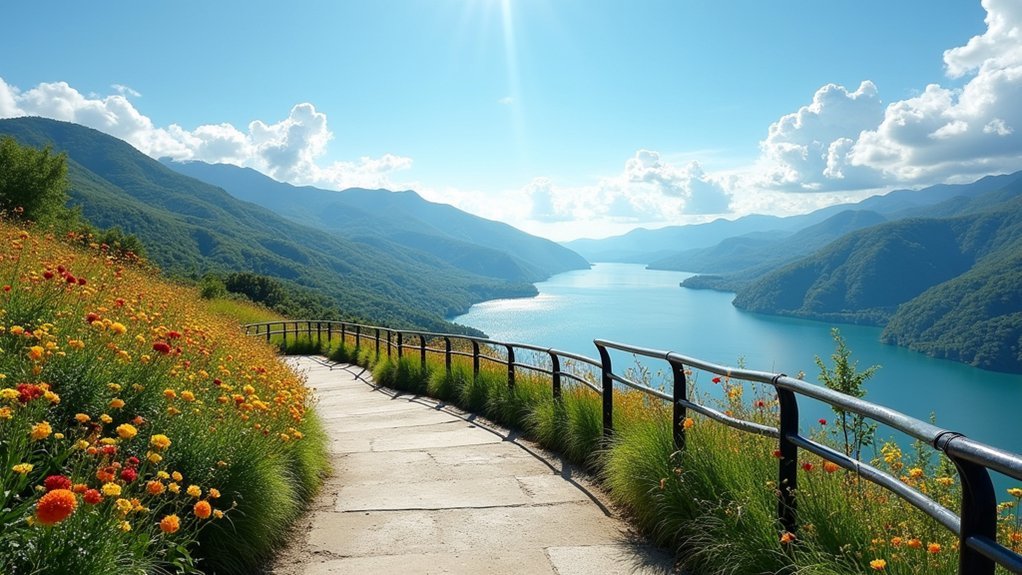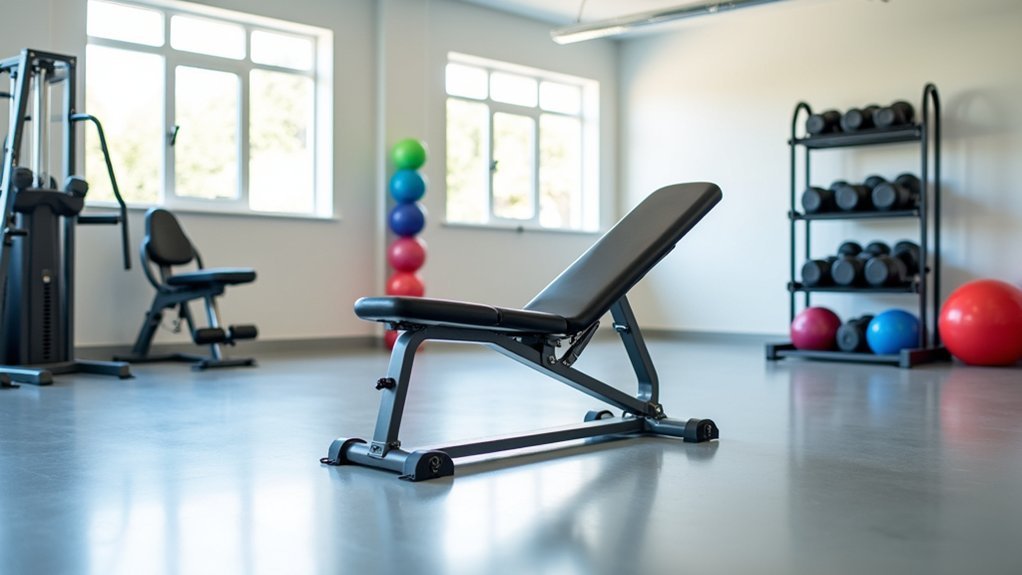Many national parks offer ADA-accessible scenic views, including the Grand Canyon’s wheelchair-friendly overlooks and Yellowstone’s boardwalk system around Old Faithful. You’ll find coastal options at Virginia Beach’s Grommet Island Park with free beach wheelchairs and urban vistas at ADA-compliant observation decks like Chicago’s Navy Pier. Technology helps too—National Park Service apps provide real-time accessibility information for planning your visit. Explore further to discover which breathtaking viewpoints accommodate your specific needs.
What Scenic Views Offer ADA Accessibility?

While enjoying America’s natural wonders once presented significant challenges for visitors with mobility limitations, today’s national parks have dramatically improved accessibility.
Now you’ll find wheelchair accessibility at numerous iconic locations across the country.
America’s parks embrace inclusion with wheelchair access at breathtaking destinations nationwide.
The Grand Canyon and Yellowstone provide accessible overlooks that don’t compromise on breathtaking views.
At Acadia National Park, you can experience Cadillac Mountain’s panoramic vistas via accessible scenic drives.
Great Sand Dunes National Park offers specialized sand wheelchairs, allowing visitors with disabilities to appreciate the impressive dune landscapes.
Denali National Park features accessible viewing areas along its main road, showcasing North America’s highest peak without difficult terrain challenges.
These thoughtfully designed scenic overlooks incorporate safety features while ensuring everyone can experience the majesty of America’s natural treasures.
National Parks Leading the Way in Accessible Overlooks
You’ll discover national parks across America pioneering universal trail designs that transform scenic overlooks into welcoming spaces for everyone.
The Grand Canyon, Yellowstone, and Acadia have revolutionized wheelchair experiences by creating barrier-free viewpoints where visitors can immerse themselves in nature’s grandeur without limitation.
These parks now employ innovative technology like tactile maps and audio descriptions to enhance access, ensuring you won’t miss the breathtaking vistas that make our national treasures so extraordinary.
Universal Trails Design
As national parks evolve to meet the needs of all visitors, they’ve emerged as pioneers in Universal Trails Design, transforming how Americans experience natural wonders. You’ll find wheelchair accessible viewing areas with clear ground space of at least 36″ × 48″ and proper slope requirements at many scenic overlooks nationwide.
| Design Feature | Accessibility Benefit |
|---|---|
| 60″ diameter spaces | Allows wheelchair turning |
| T-shaped turning areas | Enhances maneuverability |
| Regulated slopes | Prevents tipping hazards |
| 36″ × 48″ clear space | Accommodates wheelchairs |
| ADA/FSORAG compliance | Guarantees universal access |
These improvements aren’t just about meeting regulations—they’re about making sure everyone, including those with mobility issues, can experience America’s most breathtaking views. Recent renovations continue to enhance these features, making once-inaccessible vistas available to all visitors.
Elevating Wheelchair Experiences
National parks across America have revolutionized the wheelchair experience through thoughtfully designed accessible overlooks.
You’ll find Grand Canyon National Park offers wheelchair-accessible shuttle buses that transport you to scenic viewpoints where breathtaking vistas await.
At Yellowstone, the extensive boardwalk system surrounding Old Faithful guarantees you won’t miss this iconic natural wonder.
Acadia National Park’s paved carriage roads lead to stunning coastal views specifically designed with accessibility in mind.
For visitors with mobility challenges, Denali National Park features ADA-compliant trails like the Spruce Forest Trail, making wilderness exploration a reality rather than a dream.
These accessible national treasures continue evolving through the National Park Service’s commitment to ongoing accessibility assessments and improvements, assuring everyone can enjoy America’s natural wonders regardless of physical limitations.
Technology Enhancing Access
While physical improvements have transformed accessibility at scenic locations, digital innovation now plays an essential role in enhancing the experience. The National Parks Service has pioneered this effort with apps offering real-time accessibility information for wheelchair accessibility at iconic destinations like Yellowstone and Grand Canyon.
These digital tools help you plan your accessible travel by identifying which overlooks have clear ground spaces, turning areas, and barrier-free access. For visitors with mobility challenges, this technology removes the guesswork before arrival.
The apps complement the extensive boardwalk systems and ADA-compliant viewing areas constructed throughout national parks. By integrating digital resources with physical improvements that adhere to FSORAG and ABA standards, parks guarantee you’ll find breathtaking vistas that are both accessible and enjoyable regardless of mobility limitations.
Coastal Viewpoints With Wheelchair-Friendly Boardwalks
Ocean waves, salty breezes, and scenic horizons await visitors of all mobility levels at America’s accessible coastal viewpoints.
You’ll find wheelchair-friendly boardwalks that bring the beauty of shorelines within reach, ensuring everyone can enjoy spectacular scenic views.
When planning your coastal adventure, consider these wheelchair-accessible locations:
- Virginia Beach offers accessible ramps leading to ocean viewpoints with free beach wheelchairs at Grommet Island Park.
- Cannon Beach’s newly installed boardwalks provide access to Oregon’s iconic coastal vistas alongside accessible restrooms.
- The Outer Banks features Mobi-Mats at key access points, allowing you to roll right to the water’s edge for unobstructed views.
These accessible beaches demonstrate how thoughtful design can connect all visitors with nature’s most breathtaking coastal panoramas.
Mountain Vistas With Barrier-Free Observation Decks

Moving inland from coastal treasures, America’s mountains offer equally spectacular views with impressive accessibility features.
You’ll find barrier-free viewpoints at Glacier National Park that bring the majesty of glacial lakes and rugged peaks within reach for everyone.
Mount Rainier National Park features observation decks with accessible pathways and comfortable seating, ensuring you can savor mountain panoramas regardless of mobility challenges.
At Yosemite, wide viewing platforms and ramps make those famous granite cliffs and waterfalls accessible to all visitors.
The Blue Ridge Parkway provides ADA-compliant scenic overlooks with paved paths and designated parking. Many locations even have wheelchairs available upon request.
Grand Canyon National Park’s accessible overlooks remove barriers between you and one of the world’s most breathtaking natural wonders.
Urban Skylines: Accessible City Viewpoints Worth Visiting
Beyond natural wonders, America’s vibrant cities offer spectacular skyline views that don’t exclude anyone with mobility challenges.
For people with disabilities seeking accessible cities, these urban gems provide unforgettable experiences while ensuring complete independence.
Experience these accessible viewpoints that showcase our nation’s architectural wonders:
- New York’s High Line delights with its wheelchair-accessible elevated park, offering Hudson River views that are free of charge along its ramped trail.
- Chicago’s Navy Pier features barrier-free areas where you’ll enjoy the magnificent skyline from multiple vantage points, including its iconic Ferris wheel.
- Seattle’s Space Needle and St. Louis’ Gateway Arch both provide ADA-compliant observation decks with panoramic vistas that showcase their cities’ unique landscapes.
Adaptive Equipment Available at Popular Scenic Destinations

While architectural viewpoints offer incredible urban vistas, many natural wonders have become equally accessible thanks to specialized equipment now available at America’s most breathtaking destinations. You’ll find wheelchair-accessible overlooks at the Grand Canyon and sand wheelchairs at Great Sand Dunes National Park that enable visitors with disabilities to experience these natural wonders firsthand.
| Park | Adaptive Equipment | Features |
|---|---|---|
| Great Sand Dunes | Sand wheelchairs | Dune exploration |
| Yellowstone | Accessible fishing areas | Old Faithful boardwalks |
| Acadia | Paved carriage roads | Jesup Path boardwalks |
| Denali | ADA-compliant trails | Spruce Forest Trail |
Many locations also provide accessible bathrooms alongside these specialized accommodations. The extensive boardwalk system at Yellowstone guarantees everyone can witness Old Faithful’s spectacular eruptions, while Denali’s accessible trails deliver stunning mountain views.
Sensory-Friendly Nature Experiences for All Abilities
You’ll find accessible sensory trails like Acadia National Park’s Jesup Path that engage multiple senses while accommodating various mobility needs.
These trails often feature textured surfaces, fragrant plants, and audio descriptions that create immersive natural experiences without physical barriers.
Multi-sensory nature gardens with touchable plants, flowing water features, and wind chimes offer additional opportunities to connect with nature regardless of your abilities.
Accessible Sensory Trails
As nature beckons explorers of all abilities, accessible sensory trails have emerged as innovative pathways designed for inclusive outdoor experiences. These fully accessible routes feature smooth surfaces like boardwalks and paved paths that accommodate wheelchair users while providing enriching engagement with the natural world.
What makes these trails truly special is their multisensory approach:
- Tactile elements invite you to experience nature through touch at dedicated stations featuring various textures and surfaces.
- Audio components enhance your connection with nature through carefully placed sound features and natural acoustics.
- Aromatic plantings engage your sense of smell with fragrant native species strategically positioned along the path.
You’ll find interpretive signage with Braille and large print throughout, complemented by nearby accessible restrooms ensuring comfort during your sensory-rich adventure.
Multi-Sensory Nature Gardens
Designed with accessibility at their core, multi-sensory nature gardens transform traditional outdoor spaces into immersive environments where visitors of all abilities can connect with nature through multiple senses. These gardens feature accessible pathways that accommodate wheelchairs and mobility aids, ensuring everyone can explore freely.
| Sensory Elements | Benefits | Accessibility Features |
|---|---|---|
| Fragrant plants | Aromatic stimulation | Raised beds at wheelchair height |
| Textured surfaces | Tactile engagement | Braille signage |
| Water features | Auditory relaxation | Wide, firm pathways |
| Bird habitats | Wildlife interaction | Multiple seating areas |
| Seasonal plantings | Visual variety | Audio descriptions |
You’ll find thoughtfully designed spaces where visitors with disabilities can experience nature through touch, smell, sight, and sound. Many gardens also offer sensory-friendly events tailored to individuals with sensory sensitivities, creating truly inclusive outdoor experiences.
Frequently Asked Questions
What Is an ADA Accessible Path?
An ADA accessible path is a route you’ll find barrier-free, with a 36″x48″ clear space, gentle slopes (less than 1:48), adequate turning space, small surface openings, and proper guardrails where needed for your safety.
What Are the ADA Requirements for Nature Trails?
ADA requires your nature trails to have slopes no steeper than 1:12, clear spaces of 36″x48″, 60″ turning areas, firm surfaces without large gaps, and compliant viewing areas for all visitors’ accessibility.
What Makes Something ADA Accessible?
ADA accessibility means you’ll find firm, level paths, manageable slopes, adequate width for wheelchairs, handrails where needed, and clear signage. It’s about ensuring everyone, regardless of ability, can safely access and enjoy spaces independently.
What Is ADA Accessible Seating?
ADA accessible seating provides you with designated spaces that accommodate wheelchairs, mobility aids, and service animals. You’ll find these areas have proper dimensions, turning space, and unobstructed sightlines to guarantee you can enjoy experiences comfortably.
In Summary
Across America, you’ll find breathtaking views that everyone can enjoy, regardless of mobility challenges. From barrier-free mountain overlooks to wheelchair-accessible coastal boardwalks, nature’s beauty is becoming more inclusive every year. Don’t let accessibility concerns limit your adventures—research beforehand, utilize available adaptive equipment, and connect with accessibility-focused travel communities. The most spectacular vistas shouldn’t be privileges; they’re rights that belong to us all.





Leave a Reply